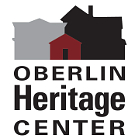A Winter Term at Oberlin Heritage Center
Tuesday, February 9th, 2010By Timothy Krumreigh (Oberlin College class of 2012)
Week One:
The first week interning at the Heritage Center was devoted to introduction and familiarization. Liz and Prue showed me around the basement and allowed me to familiarize myself with the location of resources. Additionally, Prue pulled out documents and books (i.e. Collections Goals of OHC and Introduction to Museum work) based on my interested in the museum field so I could begin obtaining some background knowledge.
Week Two:
During the second week of interning at the Heritage Center, I began to utilize the resources to start some projects. Rachel and I did a very basic inventory of 123 (formerly 21) South Professor Street for the owner. We looked through directories, at online documents, and in college guides in hopes of discovering more information about the residents of 123 S. Professor Street. Additionally, Prue showed Rachel and I two examples of scrap books and explained the problems and solutions for preserving old scrapbooks. After the discussion, Prue showed us a recently donated scrap book and demonstrated the construction of a phase box.
Week Three:
Week three of interning at the Heritage Center was really exciting. Rachel and I continued to work on the inventory of 123 S. Professor Street. We completed looking through documents and electric resources and will now move on to the final write up for the file. I went on the field trip to McKay-Lodge conservancy and was very impressed. The trip gave me a good idea of some of things that can be done with conservation and allowed me to see some of the awesome processes used in order to conserve a piece of art or historic document.
When we arrived back at the Heritage Center, Rachel and I discussed gaining experience and working with historic objects and documents with Prue. The next day, Prue collected various documents and pictures in need of preservation. She showed us the flat file of Soldiers Monument and taught us how to encapsulate the documents and pictures that were in the flat file. After walking us through the first encapsulation, she allowed Rachel and myself to encapsulate the remaining documents. On Friday, Rachel and I were given a register from the college and asked to build a phase box, with some assistance were were able to complete a box.
Week 4:
I think week four of our winter term internship was probably the most exciting. The Heritage Center sent us to a symposium in Indianapolis, Indiana for two days. The symposium was called “The Green Historic Preservation Symposium,” which was sponsored by the EPA region five. The symposium brought together people from many different fields: preservation, conservation, construction, business, and many more. The idea of the conference was to bring different minds together to figure out what’s working, what’s not working, and what needs to change in terms of green historic preservation. People are now beginning to realize that tearing down historic homes to make way for “new, green construction,” is not actually green. Green historic preservation is a new and developing idea; hopefully as this idea develops, we will see it applied in Oberlin.
Week Five:
During our last week of work at the Heritage Center, we began working more on the doll house and the objects found in the attic. I was shown how to remove the surface dirt from the furniture and toys by using vulcanized rubber. After the toys were cleaned, I recorded the type of objects so they could later be accessioned. Prue showed us how to add an accession number to the Pass Perfect program and Rachel and I printed a new deed for the found doll house items. The last big project we worked on involved writing the accession numbers on the objects themselves. This process involves different chemical and products that allow a museum to write on the object, but also remove the writing if necessary. We painted on chemicals and wrote the tiny accession numbers on the collections.
Working with the Heritage Center has given me a lot of great insight to preservation and museum work. I would like to go into the preservation and/or museum field after Oberlin, so this internship has allowed me to “get my feet wet” and get an idea of what I may be getting myself into. I had a great time working with the heritage center staff and the other winter term volunteers. I hope to continue working with the heritage center in the future.







